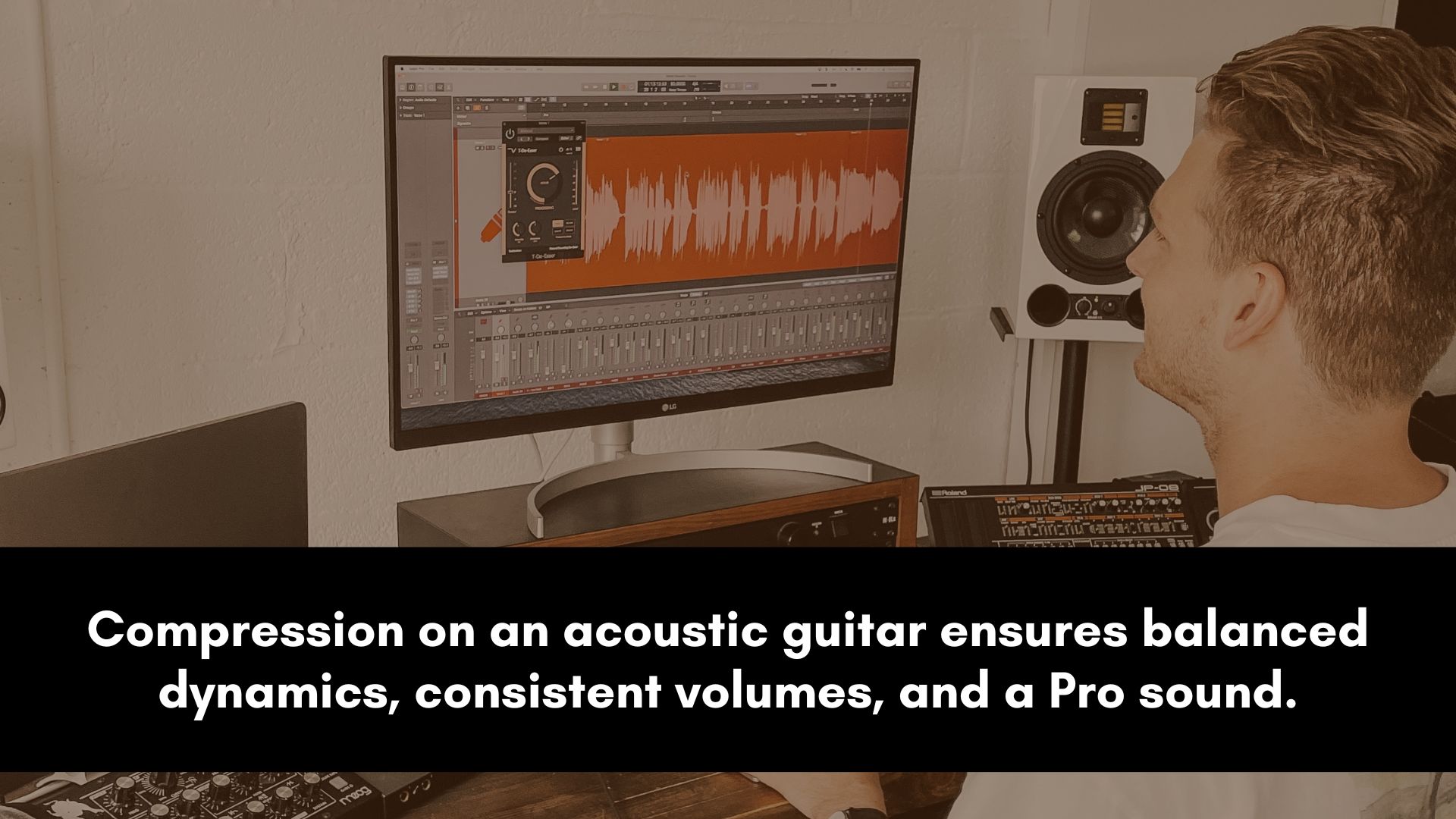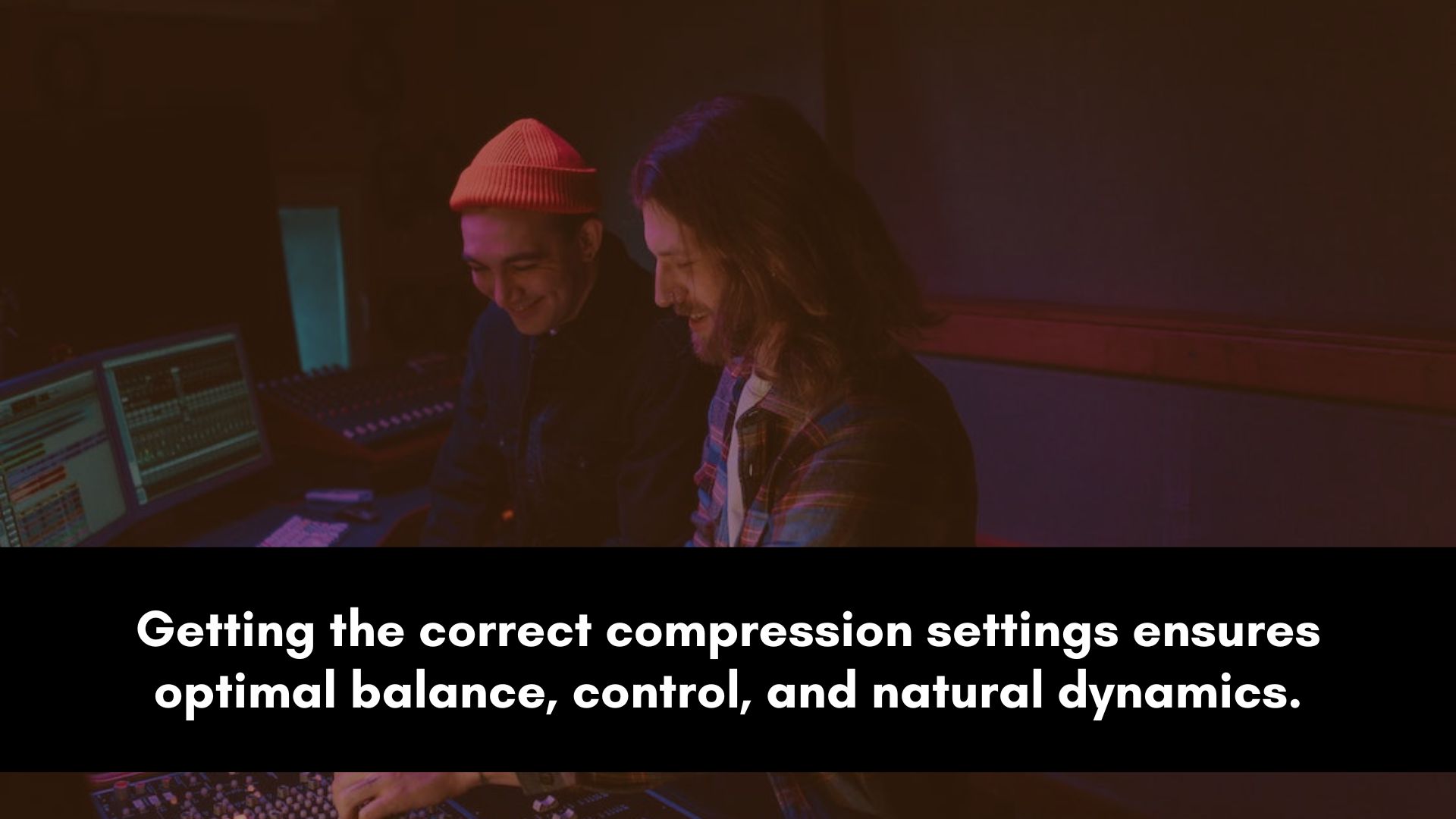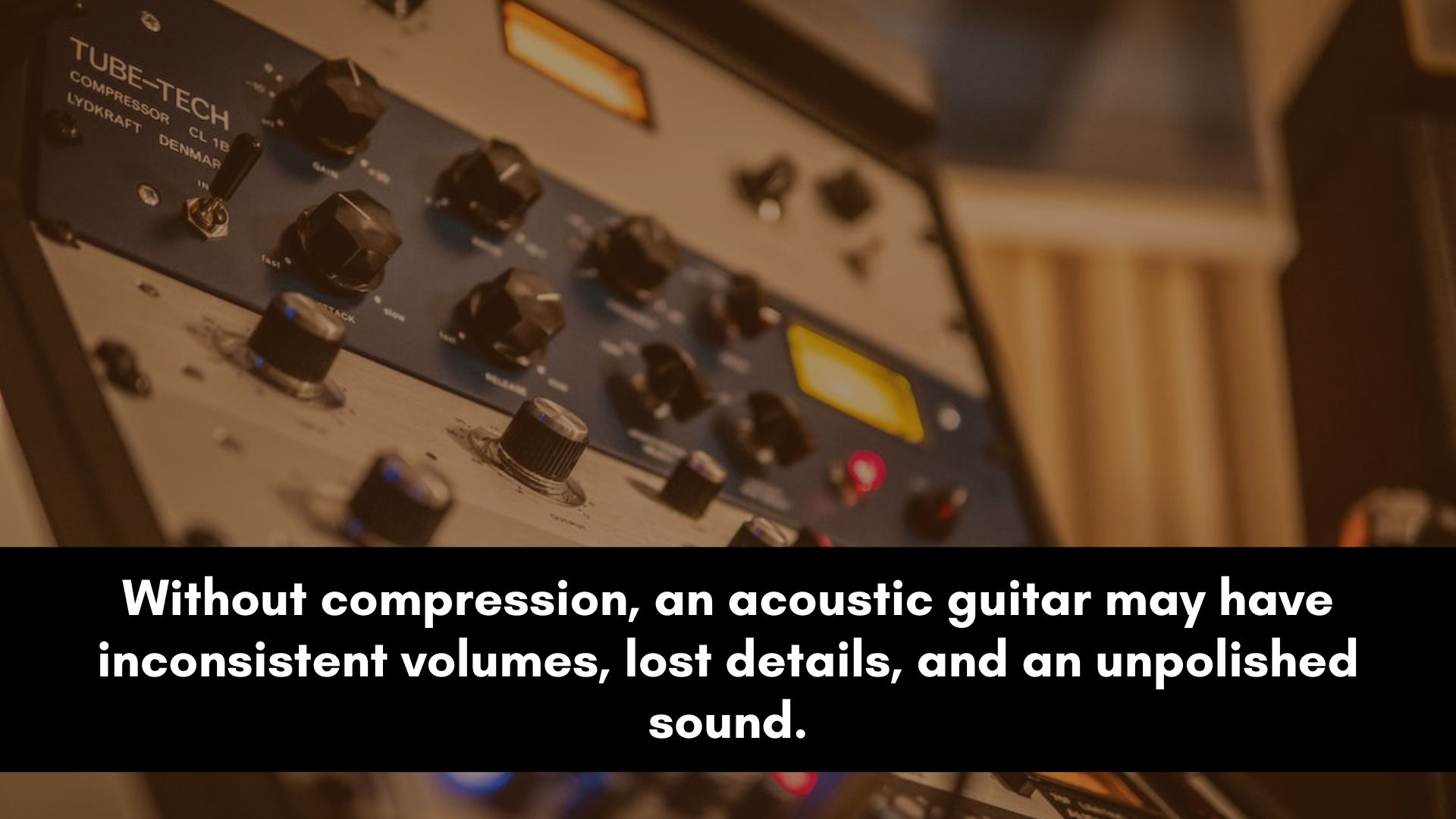Imagine a world where your acoustic guitar always sounds flawless—where every strum, pluck, and chord resonates with pristine clarity and precision.
Well, my friend, that world is within your grasp.
Welcome to our guide to unlocking the best compression settings for your acoustic guitar.
Whether you're an aspiring musician or a seasoned pro, we've got the insider tips and tricks to make your guitar sing like never before.
Say goodbye to dull and lifeless sound as we unveil the secrets to achieving the perfect balance of dynamics and expression.
How to Compress an Acoustic Guitar

Using compression when mixing acoustic guitar is crucial for achieving a balanced and polished sound.
Without compression, the guitar's dynamic range can be overwhelming, leading to inconsistent volumes and lost details.
By compressing the acoustic guitar, you can control dynamics, enhance sustain, and ensure a cohesive and professional mix.
Choosing the Right Compressor
Choosing the right compressor is crucial for achieving optimal results when compressing your acoustic guitar.
Consider the purpose of compression for your guitar, whether it's for live performances or recordings.
Start with compressors that offer transparency and flexibility. These preserve the natural sound while allowing you to fine-tune the settings.
Do your research on compressors specifically designed for acoustic instruments or known for their transparent characteristics.
Ease of use is important, so opt for compressors with intuitive controls and user-friendly interfaces.
This will make it easier for you to adjust the settings accurately.
Once you've selected a compressor, thoroughly read the manual to understand its specific features and controls.
This knowledge will allow you to make the most of its capabilities and achieve the desired compression effect for your acoustic guitar.
Take your time, experiment, and adjust the settings to achieve the desired results.
Compress Acoustic Guitar (Step-by-Step)

To effectively compress your acoustic guitar, it's crucial to set up your compressor correctly.
Follow these practical steps for a proper setup.
Begin by adjusting the input gain on your compressor to maintain a healthy signal level.
Avoid excessive input gain to prevent distortion or clipping, aiming for a clean and balanced signal.
Set the threshold control to determine the level at which compression will take effect.
Observe the gain reduction meter or listen for noticeable compression in your guitar's sound to adjust the threshold appropriately.
Choose a moderate compression ratio to control the dynamic range of your acoustic guitar.
Start with ratios like 4:1 or 6:1 for a natural sound. Adjust the ratio based on your preferences and desired level of control.
After setting the threshold and ratio, fine-tune the output gain to match the compressed signal with the uncompressed sound.
Aim for a consistent volume level without noticeable jumps when bypassing the compressor.
Continuously monitor and refine the compressed sound of your acoustic guitar as you play.
Make adjustments to the threshold, ratio, and output gain to achieve the desired compression effect.
Trust your ears and experiment to find the sweet spot that enhances the natural dynamics of your guitar.
Adjusting Attack and Release
Understanding the attack time is crucial.
Increase the attack time for a natural sound that preserves the initial transients of your guitar.
This allows the compressor to gently react to dynamic peaks without excessively squashing the transient attack.
If you're playing percussive styles on your acoustic guitar, consider decreasing the attack time.
This adjustment helps the compressor react faster to sharp transients, taming any aggressive spikes in volume.
Experiment with shorter attack times to strike a balance between controlling transients and maintaining a natural sound.
When adjusting the release time, aim for a smooth and natural decay.
This prevents sudden volume changes or "pumping" artifacts caused by overly fast releases.
Be cautious of excessively long release times, as they can result in a compressed sound lacking in liveliness and natural decay.
Find the right release time that allows the compressor to release smoothly while preserving the dynamic nuances of your guitar.
As you make adjustments, carefully listen to the impact on the overall sound of your guitar.
Make incremental changes and evaluate how they affect the compression's transparency and feel.
Continue to tweak the attack and release settings until you achieve the desired compression characteristics.
Fine-tuning the Ratio
Achieving the desired compression results for your acoustic guitar involves fine-tuning the compression ratio.
A higher ratio applies more compression, while a lower ratio applies less compression.
Strive for a balanced approach that maintains the natural dynamics of your acoustic instrument while controlling inconsistencies in volume.
Start with a moderate compression ratio, such as 4:1 or 6:1. This provides a good starting point for a natural and balanced sound.
For more transparent compression, consider using a lower compression ratio.
Be mindful not to use an extremely low ratio that may result in minimal compression, failing to effectively control dynamic peaks.
If you desire more pronounced compression and greater control over the dynamic range, gradually increase the compression ratio.
Higher ratios like 8:1 or 10:1 can effectively compress the input signal, reducing the dynamic range more aggressively.
This can be useful for certain playing styles or when a more controlled sound is desired.
As you adjust the compression ratio, carefully listen to the effect on your guitar's sound.
Pay attention to any artifacts or loss of natural dynamics.
Make incremental changes and continually evaluate the results until you achieve the desired balance between compression and the natural characteristics of the instrument.
Balancing Compression with Natural Dynamics
Achieving a professional and pleasing sound on your guitar involves finding a delicate balance between compression and preserving the natural dynamics.
Begin by relying on your ears and carefully listening to the overall sound of your acoustic guitar.
Strive for a smooth and natural transition between the compressed and uncompressed sections, ensuring the expressive qualities of your playing are maintained.
Avoid over-compression, as it can lead to a lifeless and unnatural sound.
Continuously monitor the compressed signal to preserve the nuances and dynamics of your instrument.
Fine-tune the threshold and ratio settings to strike a balance between controlling dynamic peaks and maintaining an organic sound.
Avoid aggressive settings that excessively compress every note, as this can diminish the liveliness of your guitar.
Utilize the makeup gain control to compensate for any volume loss caused by compression.
Be cautious not to overcompensate, as this can introduce unwanted artifacts or excessive amplification.
Finally, evaluate the attack and release settings, as they significantly impact the perceived dynamics and naturalness of your guitar's sound.
Make subtle adjustments to find the ideal balance that complements your playing style and preserves the instrument's character.
Ultimately, trust your musicality and personal preferences when balancing compression with the natural dynamics of your acoustic guitar.
Compression Techniques for Acoustic Guitar

When it comes to compressing an acoustic guitar, using the right techniques can make a significant difference in achieving a polished and balanced sound.
Explore the following compression techniques to enhance the dynamics of the guitar.
A Gentle Touch
Opt for a gentle approach to compression to retain the natural dynamics of the sound.
Set a moderate compression ratio and adjust the threshold to control any sudden volume spikes without overly squashing the guitar.
This technique helps maintain the expressive qualities of your playing while providing subtle control over dynamic inconsistencies.
Parallel Processing
Parallel compression, also known as New York compression, involves blending a heavily compressed signal with a dry, uncompressed signal.
This technique adds sustain and body to your acoustic guitar while preserving its original nuances.
Adjust the blend or mix control to achieve the desired balance between the compressed and uncompressed signals, allowing for a more subtle and transparent effect.
Experiment with Multiband Compression
Multiband compression enables you to target specific frequency ranges, allowing for more precise control over the guitar's dynamics.
This technique is particularly useful when certain frequency bands require additional compression while others remain untouched.
Adjust the compression settings for each frequency band to achieve a balanced and consistent sound across the entire frequency spectrum.
Consider Using a Serial Compression Chain
For more complex compression needs, you can employ a serial compression chain.
This involves using multiple compressors in succession to apply different levels of compression at various stages.
For instance, you can use one compressor to address specific frequency ranges or loud transient peaks before equalizing the acoustic guitar.
Then add another compressor to control the overall dynamics after surgical EQ.
Experiment with different compressor combinations and settings to achieve the desired level of compression and tonal control.
FAQ:
Should you compress an acoustic guitar?
Deciding whether to compress an acoustic guitar depends on factors like dynamic range control, playing style, genre, and recording environment.
Compression can help balance the volume variations and achieve a polished sound in genres like pop or rock.
However, for dynamic and expressive styles (jazz, folk, etc.), preserving the natural dynamics may be preferred.
Consider the recording environment; compression can be useful in live performances or less controlled settings.
It's important to find the right balance to retain the acoustic guitar's tonal character while controlling dynamics.
Ultimately, the decision to compress is subjective, and experimentation is key to determining what enhances the organic qualities of your guitar.
What does a compression pedal do for an acoustic guitar?
A compression pedal helps control the dynamic range by evening out the volume differences between soft and loud notes.
This usually results in a more balanced and consistent sound.
The pedal enhances sustain by extending the decay of the notes, which is particularly useful for melodies and chords.
It also helps control transients, ensuring a more even and consistent attack.
Using a compression pedal improves overall performance by smoothing out volume inconsistencies.
Additionally, it can shape the tone of the acoustic guitar, adding warmth and emphasizing certain frequencies.
How much compression should an acoustic guitar have?
The amount of compression that an acoustic guitar should have is subjective and depends on factors like personal preference, playing style, genre, and the guitar's characteristics.
The goal is to achieve a consistent and controlled sound without sacrificing the dynamics.
Consider the genre; some genres may benefit from more pronounced compression for a consistent sound, while others prioritize a more organic and dynamic feel.
Experiment with different settings, adjusting the threshold, ratio, attack, and release, and trust your ears to find the balance that enhances your acoustic guitar's sound in a way that appeals to you.